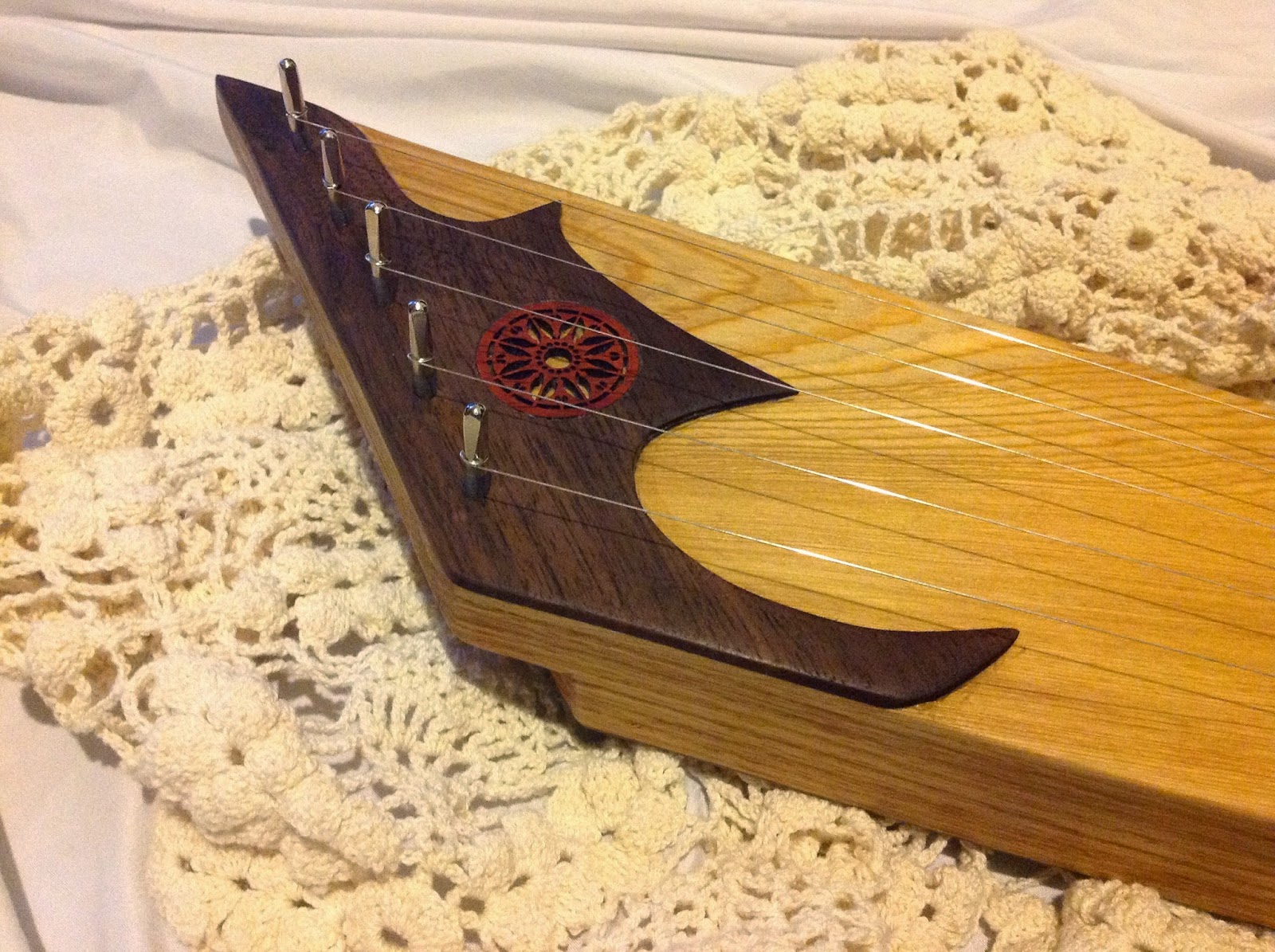 Luckily during my build of Kantele #002, I had exactly enough wood to make another 8 string kantele. So I did, and made Kantele #003 a twin of the previous. It has a different theme, but made of the same exact woods with the same exact dimensions. Interestingly enough, the sound is very different. I will do a comparison of these two in a future post. I will say however, that I really like the tone of #003, and feel that it is a significant improvement, much more mellow and rich.
Luckily during my build of Kantele #002, I had exactly enough wood to make another 8 string kantele. So I did, and made Kantele #003 a twin of the previous. It has a different theme, but made of the same exact woods with the same exact dimensions. Interestingly enough, the sound is very different. I will do a comparison of these two in a future post. I will say however, that I really like the tone of #003, and feel that it is a significant improvement, much more mellow and rich.

 Though the woods are the same, there is definitely a noticeable difference in style. This kantele uses kind of a "curl" theme, reflected in the ponsi, headboard, and "f-hole" soundhole. The dragon flairs on this ponsi was particularly fun and challenging to carve, being my first attempt at such type of carving. Despite having an unusual grain, I found the leopardwood very nice to carve and hold its shape, but one must work with the grain flow to avoid chipping or tearing of the wood. Another unique feature of the ponsi is the carved top and front profile. This was inspired by the geometric chip carving style, and was also a first for me as well. The inside curve where the varras, or string-holding bar is located, is also a noticeable improvement from the previous two, which has a very round vertical profile as opposed to the more flat-sawn curve shape of its predecessors. The decorative headplate is simpler than #002, and cleaner all around than the previous. I had bought another padauk rosette to inlay, but felt that the added wood to accommodate it would make the headplate unnecessarily bulky. There is also less overlap onto the vibrating portion of the soundboard, possibly contributing to its overall better tone. #003 turned out only slightly wider in size, but all other dimensions remained the same. I do feel that the cypress used for this soundboard was also a bit nicer quality than #002.
Though the woods are the same, there is definitely a noticeable difference in style. This kantele uses kind of a "curl" theme, reflected in the ponsi, headboard, and "f-hole" soundhole. The dragon flairs on this ponsi was particularly fun and challenging to carve, being my first attempt at such type of carving. Despite having an unusual grain, I found the leopardwood very nice to carve and hold its shape, but one must work with the grain flow to avoid chipping or tearing of the wood. Another unique feature of the ponsi is the carved top and front profile. This was inspired by the geometric chip carving style, and was also a first for me as well. The inside curve where the varras, or string-holding bar is located, is also a noticeable improvement from the previous two, which has a very round vertical profile as opposed to the more flat-sawn curve shape of its predecessors. The decorative headplate is simpler than #002, and cleaner all around than the previous. I had bought another padauk rosette to inlay, but felt that the added wood to accommodate it would make the headplate unnecessarily bulky. There is also less overlap onto the vibrating portion of the soundboard, possibly contributing to its overall better tone. #003 turned out only slightly wider in size, but all other dimensions remained the same. I do feel that the cypress used for this soundboard was also a bit nicer quality than #002.

 I also chose a much nicer curly hard maple board to use for the backboard, which has much more noticeable and attractive figure than #002. Curly hard maple takes a beautiful polish, and with the curl can provide quite a stunning look. The soundhole was quite a bit more challenging: since I already glued the backboard on before cutting it out (to ensure it went on straight, since it can slightly move around during the gluing process), I had to drill many tiny holes along the outline of the shape, then slowly cut away the shape with a very sharp knife and chisel by connecting the dots. The larger soundhole also not only lends itself nicely to the overall theme, but provides more volume while still keeping the aesthetics of a backboard.
I also chose a much nicer curly hard maple board to use for the backboard, which has much more noticeable and attractive figure than #002. Curly hard maple takes a beautiful polish, and with the curl can provide quite a stunning look. The soundhole was quite a bit more challenging: since I already glued the backboard on before cutting it out (to ensure it went on straight, since it can slightly move around during the gluing process), I had to drill many tiny holes along the outline of the shape, then slowly cut away the shape with a very sharp knife and chisel by connecting the dots. The larger soundhole also not only lends itself nicely to the overall theme, but provides more volume while still keeping the aesthetics of a backboard. Extra Sources and Info:
1.) Kantele #001 Info: http://oertheeternalstrings.blogspot.com/2014/10/kantele-001.html
2.) Kantele #002 Info: http://oertheeternalstrings.blogspot.com/2014/11/kantele-002.html
.JPG)

.JPG)

.JPG)





